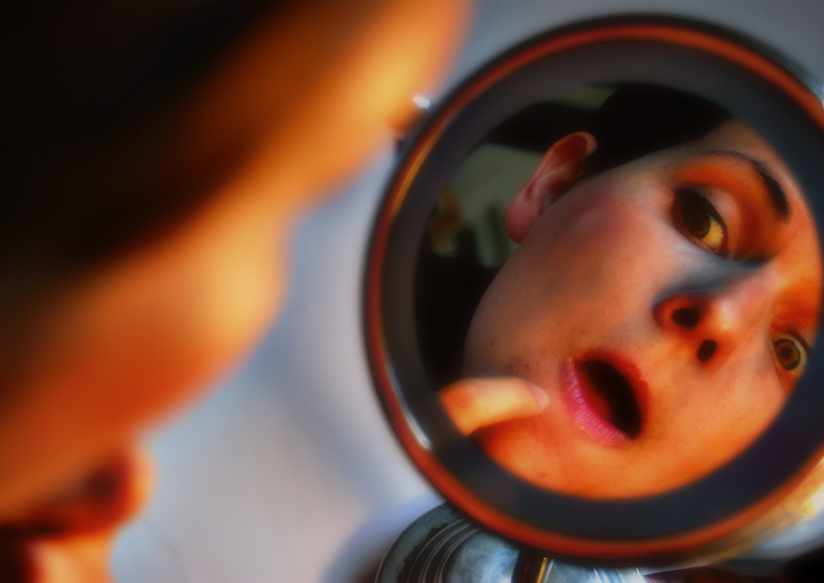
While acne was formerly seen as an infectious skin disease, more recent data have revealed acne to be primarily an inflammatory process in the skin. Acne is therefore today seen as a chronic inflammatory skin condition (bacterial overgrowth is of course also present, but it’s not of single-handed importance, as was thought before).
Overall, acne is a multifactorial process with the following contributing pathogenetic factors:
1.) Genetic predisposition
2.) Micro-inflammation
3.) Hormonal influences
4.) Hyperkeratinization in the follicle
=> clogged pore
=> sebum can’t flow out freely
=> comedone formation (ie blackheads, whiteheads, micro-comedones)
5.) Acne bacteria overgrowth
With regards to hormones it’s in particular the male hormones that trigger acne. You see, not only men, but also women have male hormones such as testosterone in their bodies, albeit at much, much lower levels. However, if the effects of these male hormones become overbearing, this can lead to acne flare-ups.
Many female acne sufferers will also experience a flare-up just before or during their menstruation. At this time of the month, women often observe development of pimples and spots, caused by a change in the levels and ratios of sex hormones in our body. During ovulation, ie mid cycle, excess sebum gets produced in the dermis (ie the skin gets oilier), which can get trapped in our pores, if the exit is blocked by dead skin material (keratin). These non-inflamed acne lesions (comedones) later get invaded by bacteria and turn into spots/pimples (ie inflamed acne lesions), often just before or during the period. Testosterone levels are also up as the body gets ready to menstruate, which also contributes to breakouts.
We have been seeing a strong increase of acne affecting adult women here at Eudelo. Acne can be worsened by various environmental factors, including a diet rich in sugar and processed carbohydrates / starches, smoking, wrong skincare (an extremely common contributing factor we often see at Eudelo!) as well as stress and lack of sleep. Some acne sufferers may react negatively to dairy (studies have shown that skimmed milk is more ‘risky’ compared to full-fat!), but that’s a minority.
In adult acne patients we see at Eudelo, the majority of them are not using optimal skincare, as overly rich skincare that will contribute or aggravate their acne. This may be because woman are seeing first lines and wrinkles and want to start using anti-ageing creams, which tend to be quite rich in consistency, hence triggering acne in predisposed individuals.
One of the differences between teenage acne and adult acne is that adult acne skin tends to be less oily (and on average with less comedones, but more inflammatory lesions, compared to teenage acne). Adults suffering with acne often report combination or even “dry/sensitive” skin (which often actually turns out not to be true from a dermatologist point of view…) which makes treatment more challenging than acne treatment in teenagers, who tend to have more ‘robust’ oily skin.
The fact that adult acne sufferers often feel they have dry and/or sensitive skin often makes them apply too rich skincare (sometimes even oils including facial oils, cleansing oil, coconut oil and others), which is a really bad idea for any breakout prone skin, as it will aggravate inflammatory lesions.
However, the good news is that there are highly effective anti-inflammatory prescription creams available from a dermatologist. Adult acne is easy to treat in the vast majority of cases, we do it at Eudelo every day.
The best approach is to use preventative creams that prevent new spots from developing. Ideally treatment is a combination of anti-inflammatory, keratolytic (‘pore unclogging’) and anti-bacterial effects.
And if you suffer with acne well into your adult year, but are also concerned with wrinkles, you might be interested to hear about prescription creams that not only control spots, but give great anti-ageing results too! One example is tretinoin cream, which is not only a strong collagen stimulating ingredient, but also helps repair past sun damage.
Then there are those prescription creams that improve both breakouts and pigmentation issues (e.g. azelaic acid cream), which is great, if you start to notice irregular pigmentation as part of the skin ageing process or if pimples leave dark marks for some weeks to months.
There are also certain non-prescription ingredients such as retinol, retinaldehyde, glycolic acid and salicylic acid that can help prevent breakouts. They do this mainly by supporting healthy exfoliation, thus prevention sebum getting trapped in the skin and pores getting blocked.
For anybody with a tendency for breakouts I strictly advice against using facial oils of any sort, as they clog up pores and ‘congest’ the skin, aggravating breakouts (even if the company swears they don’t…). This is also true for tea tree oil (which is often even marketing for acne!), which may have mild anti-inflammatory effects, but its pore-clogging properties in my professional experience greatly outweigh the mild anti-inflammatory benefits.
With regards to lifestyle changes, we recommend avoiding lipid-rich creams and oils, try to lower your stress levels and avoid a high-glycaemic diet.
However, our main message remains, adult acne, even if mild, is a medical skin condition that benefits from prescription cream treatment, as you can only do so much with lifestyle changes and over-the-counter solutions.
There are also various effective in-clinic treatments to support the acne treatment. A highly useful adjunct for any acne sufferer is in fact a monthly dermatology grade facial. One of the most beneficial steps to acne control is the thorough extraction of comedones, because all spots start as comedones. For that reason I recommend anybody with acne to attend monthly dermatology grade acne facials. However, make sure it’s a dermatology grade facial, not a spa or high-street facial, as these have been shown to often aggravate acne and should be avoided in anybody with breakouts.
Certain types of peels, containing for example glycolic and/or salicylic acid, as well as blue LED light treatment can also be helpful as a therapeutic adjunct, but should replace prescription treatment.
If acne scaring is a concern, this can be treated with for example a course of PRP Needling. However, acne scaring must only be tacked once ALL active acne is cleared (a common mistake to try treat acne scaring, while you still get active spots/pimples)!
Whether you have a medical skin condition which needs treatment or simply want to look your very best, our specialised dermatology team will help you achieve the very best result.

